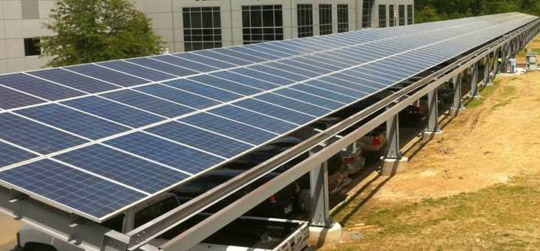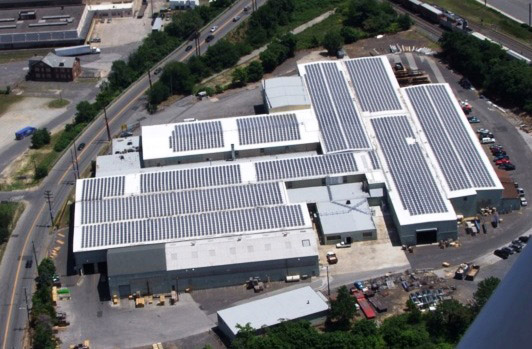Smart Power Move: Solar as a Crucial US Energy Component
Living and acting in an environmentally conscious way and finding a balance between economics, environment and society is, historically, not a new concept. However, it is a relatively new concept for the United States – a vast country of open spaces, abundant beauty and seemingly endless resources. Until recently, the 3Rs of “reduce,” “reuse” and “recycle” were the mantra of only a small percentage of America’s population. The advent of the energy crisis in combination with the recent economic meltdown has caused millions of families to pinch pennies to make ends meet. Within this backdrop of seemingly dire circumstances, energy efficiency adjustments like LED lighting or changes in consumer behavior (e.g. reusable water bottles) have become sure-fire ways to save money while moving towards energy security for current and future generations.
The U.S. is unequivocally the world’s largest energy user. Its 300 million citizens are gobbling up almost one-quarter of the energy used globally by the world’s seven billion people. The roughly 4 Giga tons of oil equivalent Americans burn each year is more than the combined total used by all Asian countries – yes, more than China, India and the rest of Asia combined. The International Energy Agency’s (IEA, www.iea.org) 2011 World Energy Outlook forecasts that by 2030 consumers will use a mindboggling 30,000 Tetra Watt Hours of energy worldwide. Throughout the next 20 years, global energy consumption will almost double, and Asian countries, eager to catch up with the U.S., seem to have the greatest hunger for energy. Still, while this poses immense challenges for Earth’s population, there is good news. IEA anticipates renewable energy will add the greatest capacity to the power generation mix – 2,500 GW, more than any other energy source.
Developing economies yanking on the energy chain combined with ongoing conflict in regions with the greatest oil capacity provide a clear case for reconfiguring America’s energy investment. Power shifts and economic crises abroad and at home remind everyone of existing worldwide interdependencies. This tricky interconnectedness, which is more apparent today than ever before, has instilled in many the wish not only for a better future but also for a more sustainable and stable world.
One of the most prevalent sustainability topics for 2011 and 2012 to date has been solar. In fact, 2011 was the solar industry’s best year ever with more installations in just the third quarter than in all of 2009 combined. A record total 3.1 GW of grid-tied solar is now installed in the U.S., and the outlook for 2012 is just as promising. The Solar Energy Industry Association is predicting a sharp rise in utility-scale solar projects for 2012 with ever decreasing payback periods and more readily available financing and incentives. With fossil fuel prices continuing to rise, not to mention the environmental and economic implications of increasing greenhouse gas emissions, solar is a common sense option with something to offer everyone. According to industry experts, no other power source is this versatile.

© Mage Solar
Electricity from the sun can be created via amorphous (thin film) or crystalline silicone (photovoltaic) technology. In both applications, it is light photons creating an electron chain reaction in certain semiconductor materials which convert solar to electricity. Two advantages of thin film are its light weight and flexibility, which make it a good choice for mobile solutions. Since thin film can literally be rolled out, cut and pasted onto surfaces, it is the fastest way on the market to create energy. However, its convenience and ease of application are countered by its lack of efficiency and durability. Thin film only converts about 6 to 8 percent of the sunlight it absorbs into electricity, and the average thin film warranty is 10 to 15 years, compared to 25 or 30 years for market-leading PV-modules. These features can make thin film an expensive option with large demands for space. In other words, it can take twice as much thin film material to produce the same amount of energy as conventional silicone modules.
Although somewhat more labor-intense in installation, mono or polycrystalline PV-modules are still a fast-track way to produce electricity. Germany, one of the planet’s most solar-savvy countries, installed 3GW of solar in December 2011 alone. To put this into perspective, it took the Germans four weeks to implement more power than a nuclear or coal-powered plant can produce with its infinitely longer planning, permitting and construction time. And once the PV-array is up and running, energy users are tapping into the universe’s most readily available, abundant and reliable energy source. Every minute enough sun shines on Earth to cover the world’s energy needs for one entire year. To top it off, the United States is blessed with a quality of sunshine other countries can only dream of. Germany, for example, the world’s solar energy leader, has less sunshine than Alaska. Americans, on the contrary, have a true goldmine in the sky that can be tapped in all fifty states year round. PV-modules like sunshine but don’t need heat to produce well. Contrary to popular belief, PV-modules can produce electricity perfectly in freezing temperatures while extreme heat can actually reduce the efficiency of an array.
Particularly during the afternoon hours between 12 and 5, when air conditioners are buzzing, factories are producing and people are using appliances, computers and TVs, PV-arrays are soaking up the sun and putting out the most energy. In short, solar energy is quickly generated when and where it is needed most. The fact that solar power crests during peak demand hours on the electric grid is just one reason why solar should be an important part of America’s national energy mix. Delivering more solar electricity during these times is a sensible solution to reducing cost and saving money.
Solar has the advantage of adding an element of economic security and reliability into the nation’s energy mix. At the moment a solar array installation is complete and commissioned, its owner locks into one fixed power rate for as long as the system produces. Some leading manufacturers grant an 80 percent power guarantee for 30 years on their PV-modules. That is the equivalent of three decades of predictable, stable electricity prices or your money back. It is true that implementation of renewable energies is an investment with upfront costs, but more consumers, especially utilities, are finding that solar pays. Since early 2010 the ldquo;per-Watt-cost” for large-scale (1 MW and up) PV-projects has decreased from US$5.71 to US$3.40 by year-end 2011. It is no surprise that within this same time period the market segment for ground mounts (the typical utility-scale installation) realized an increase from 72MW to 311MW in the U.S. With similar dramatic price reductions on the residential and smaller to mid-size commercial side, solar is achieving grid parity (the point where solar-created energy is equal to or less than the price of electricity purchased from the grid) faster and more widespread than expected. A historic solar-nuclear crossover took place in summer 2011. For the first time, solar-generated electricity was less expensive than electricity created from nuclear power plants.

© Creative Solar USA|A 100kW canopy doubling as charging station for EVs in a company parking lot.
Municipalities with available space, like in the Southeast and Southwest, are progressively discovering that idle wide-open land can be put to use to produce clean, non-polluting energy – quietly, safely and with no harmful environmental impact. Other prime “sunny spots,” such as Hawaii, the Caribbean or Latin America, previously had no energy alternatives except for higher priced oil and gas based on their remote location or infrastructure challenges. Now they do. Home and business owners, as well as utilities and even municipalities, are realizing that solar PV’s fast, clean and efficient potential to energize homes, factories or entire towns is a reliable and powerful way to secure electricity. And with this energy security comes economic promise and possibilities for growth that were formerly unimaginable.
Thanks to incentives, energy programs and tax credits available on a state, local, utility and federal level, the upfront costs of installing a PV-system can be lowered or, in some cases, completely erased. The Department of Energy has compiled a helpful database and valuable research tool on various incentives and programs (www.dsireusa.org). Many PV installers are also making smart leasing and financing options available to customers to cover the remaining balance after grants and cash programs are exhausted. In addition, a California study revealed that homes with a PV-system in place have about a 10 percent higher resale value.
One seldom mentioned attribute of solar lies in its American character. It really is the last frontier – the third dimension in the hunt for energy independence. Within the past 150 years, consumers have exploited more than one-half the world’s oil reserves from the ground that took millions of years to form. With a fierce appetite for energy, Americans are burning 1.4 million tons of coal in the U.S. per year with indescribable consequences to health and environment. Now the U.S. has resorted to expensive and, arguably, risky shale drilling and fracking methods to extract natural gas from the earth. Chernobyl and Fukushima have shown how nuclear energy is as powerful as it can be destructive. And, wind and water have been supplying power for hundreds of years and are, deservedly, making a big comeback as renewable energy options. However, using the 4.5 billion year-old Sun to satisfy energy needs is relatively new. America’s ability to take a revolutionary technology and turn it into something life-changing and well-working on a large scale is firmly written into the genetic code of its nation. Americans have repeatedly demonstrated that progress and technology are not privileges for only a few to share but a right to all. And, doubtless, solar energy will be no exception.
Solar is a sustainable and highly economic energy source that works equally well for everyone. No matter where home is, almost every place on Earth has enough high quality sun for power generation. More importantly, solar is flexible, affordable and available at one’s fingertips. Whether it is a 5kW installation on a homeowner’s roof, a 10 kW sun tracker that is battery-backed, a 100kW canopy in a company parking lot doubling as a charging station for electric vehicles or a 1 MW power supply for an entire plant or subdivision, solar technology is so delightfully scalable and universally adaptable that it works for everyone equally – no matter how big or small the energy needs. Solar puts people in charge of their energy and environmental future, empowers everybody alike and gives nations back their energy independence.

© Philadelphia Sign Company|1 MW system made this a net-zero manufacturing plant.




























